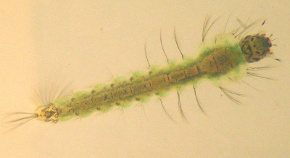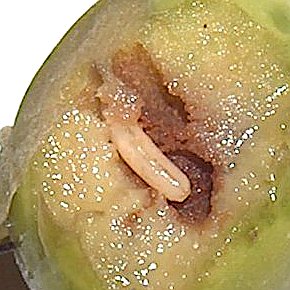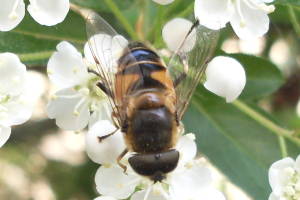Table of contents
Recurrent features - Appearance of the head - Bibliography
Author: Steffen Dietzel (Wikimedia Commons)
Resized from the original picture
(License: Public Domain)
The Diptera are insects with a complete metamorphosis, therefore they have a postembrional development that takes place through stages very different from the imago in morphology and anatomy. We should also be said that in most groups the biology of larvae differs from that of adults in many ways (habitat, nutrition, ecology, etc.)
The long evolutionary history, with the adaptation to various behaviors and environments for about 240 million years, produced a deep differentiation of larval stages and unlike other insects, the Diptera show a conspicuous variety of larvae. It is not possible to treat a morphological type which can be representative of the entire order and it is not possible to define a univocal key that can determine the Diptera in the larval stage (Teskey, 1981; Matile, 1993).
Recurrent features
To a rough approximation, the larvae of Diptera are vermiform with subconical or subcylindrical shape, sometimes more or less flattened by lateral view, and with a segmentation more or less perceptible.

The head is at the left.
Author: Sturgis McKeever, Georgia Southern University, Bugwood.org.
Resized from the original picture at Insect Images
(License: Creative Commons BY-NC)
The only featur shared by the larvae of all Diptera is the lack of true thoracic legs (Teskey, 1981; Stackelberg, 1988; Matile, 1993). This feature allows the easy distinction of larvae of Diptera by eruciform larvae of Lepidoptera, Mecoptera, or Hymenoptera Symphyta, which are also vermiform. However the lack of thoracic legs in the larvae is not a prerogative of the Diptera, because it recurs also in other orders, such as Hymenoptera and some groups of Coleoptera. Despite this, the larvae of Diptera are still recognizable by their behavior: while the apodous larvae of other orders are usually swollen and have slow and undirected movements, the larvae of Diptera are slender and have directed movements (Teskey, 1981; Matile, 1993).
Appearance of the head
A first classification of the larvae of Diptera is based on the comparison between the head and the rest of the body. This distinction is roughly related to the main groups in which the order Diptera is historically divided: Nematocerous, orthorrhaphous Brachycera, and cyclorrhaphous Brachycera. According to this criterion, the larvae of Diptera are distinct into eucephalic, hemicephalic, and acephalic.

Author: Giancarlo Dessì
(License: Creative Commons BY-NC-SA)
The eucephalic larvae (Fig. 1) have a well developed head, with the cephalic capsule sclerotized and distinct from the thorax. The mouthparts include opposing mandibles which move in a horizontal plane. This structure is a primary condition and recurs in most of lower Diptera (Nematocerous).
The hemicefalic larvae (Fig. 2) have a reduced head, poorly developed in the posterior portion, with the cephalic capsule partially retracted into the thorax. The mandibles move in a vertical plane due the strong reduction of the labrum. This structure is a condition recurrent in most lower Brachycera (Orthorrhaphous).
The acephalic larvae (Figg. 3 and 4) have a greatly reduced head, completely enclosed into the thorax. It remains a retractile capsule that bears the mouthparts. These are strongly modified and transformed into an apparatus called cephalopharyngeal skeleton, that is the basic morpho-anatomical structure of this type of larvae. The structure of acephalic larvae is the apomorphic condition of upper Diptera (Cyclorrhaphous). It should be noted that the word "acephalic" is not appropriate (Teskey, 1981; Courtney et al., 2000), because it refers to the appearance of larvae that anyway have the cephalic segments. However, the use of the term in literature is deeply ingrained, that Authors retain this terminology according to the tradition.

Author: Giancarlo Dessì
(License: Creative Commons BY-NC-SA)
The relation between the morphology of larvae and the taxonomy should be considered only as approximate when it involves paraphyletic groups (Nematocerous and Orthorrhaphous), because there are exceptions (Courtney et al., 2000): for example, among the Nematocerous, some groups have larvae definable as hemicephalic or acephalic (Cecidomyiidae and Tipulidae), while among the lower Brachycera there are groups which have larvae near to eucephalic type (Stratiomyidae). Instead, the reduction of cephalic structures and the retraction into the thorax, that is a basic feature of the acephalic larvae, is an apomorphic condition of the clade of Cyclorrhapha (=Muscomorpha sensu McAlpine, 1989).
Bibliography
- Courtney, W.G.; Sinclair, B.J. & Meier, R. (2000) 1.4. Morphology and terminology of Diptera larvae: 85-163. In Papp, L. & Darvas, B. (eds-) Contributions to a Manual of Palaearctic Diptera. Volume 1. General and Applied Dipterology, Work cited.
- Matile, L. (1993) Morphologie des Diptères: 54-96. In Diptères d'Europe Occidentale. Tome I, Work cited.
- McAlpine, J.F. (1989) Phylogeny and classification of the Muscomorpha: 1397-1518. In Borkent, A.; McAlpine, J.F.; Wood, D.M. & Woodley, N.E. (eds.) Manual of Nearctic Diptera. Volume 3, Work cited.
- Stackelberg, A.A. (1988) Order Diptera. Introduction: 1-39. In Bei-Bienko, G.Y. & Steyskal, G.C. (eds.) Keys to the Insects of the European Part of the USSR, Volume V: Diptera and Siphonaptera, Part I, Work cited.
- Teskey, H.J. (1981) Morphology and terminology - Larvae: 65-88. In McAlpine, J.F.; Peterson, B.V.; Shewell, G.E; Teskey, H.J.; Vockeroth, J.R. & Wood, D.M. (eds.) Manual of Nearctic Diptera. Volume 1, Work cited.
- Tremblay, E. (1991) Ordine Diptera (Ditteri): 11-20. In Entomologia applicata. Volume III Parte I, Work cited.
Creative Commons BY-NC-SA 3.0 Unported License
(BY: Attribution - NC: Noncommercial - SA: Share Alike).


